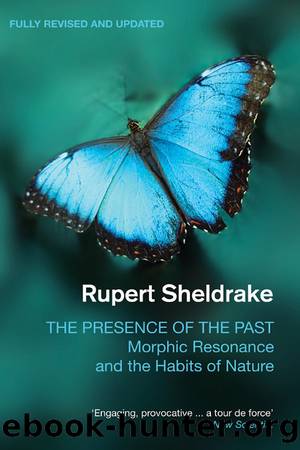The Presence of the Past: Morphic Resonance and the Habits of Nature by Rupert Sheldrake

Author:Rupert Sheldrake [Sheldrake, Rupert]
Language: eng
Format: epub
Tags: Biology, Educational, Environment, Life Sciences, Nature, Non-Fiction, Philosophy, Psychology, Science, Sociology
ISBN: 9781848313132
Google: SyeKFT9hPTUC
Amazon: B001JT6GM2
Publisher: Icon Books Ltd
Published: 2011-06-30T23:00:00+00:00
Figure 10.1 The results of Suitbert Ertelâs experiment on the recognition of hiragana characters. The vertical axis shows the number of words recognized and the horizontal axis the six successive trials. (Reproduced by courtesy of Suitbert Ertel)
However, Ertelâs fake hiragana characters were designed to look like real hiragana characters when they were the right way up. Insofar as they resembled real hiragana characters, it may be that they did so precisely because they had a âright way upâ feel to them, because of a generic resemblance to real characters. This âintrinsic factorâ may not be an alternative to morphic resonance, but depend on their generic resemblance to right-way-up hiragana characters, which was built in from the start. But the complexity of Ertelâs interpretations illustrates how difficult it is to obtain clear-cut results in old-field experiments.17 A further complication was that Ertel unwittingly used an obsolete hiragana script that went out of use in the 1930s, that even Japanese people find hard to recognize today.
Several subsequent projects using unfamiliar scripts have given results that support the initial finding of Schwartz and Pickering, and much of Ertelâs work. At the University of Leipzig, Germany, Dirk Baumeier carried out a study in which subjects memorized real and false Japanese words, written phonetically in Roman characters, without knowing that some were real and the others were meaningless anagrams of the real words. Subjects remembered the real words significantly better than the false ones.
In a second study, Baumeier presented his subjects with a series of real Japanese words (written in Kanji script) as well as lists of real words in Indonesian, Swahili and Sanskrit, written phonetically in Roman script. Beside each real foreign word were two German words, one of which had the same meaning as the foreign word, while the other was completely unrelated. They had to try and guess which German word had the same meaning. By chance they would have been right 50 per cent of the time, but in a total of 11,200 guesses, 54 per cent were correct, which were very significantly above chance. He concluded that his results supported the hypothesis of morphic resonance.18
At the University of Innsbruck, in Austria, Robert Schorn, Gottfried Tappeiner and Janette Walde compared real Russian words written in Cyrillic script with meaningless anagrams of these words. The real and false stimuli were presented in pairs, and the participants asked to judge which had more âspiritâ. The real words were selected significantly more than the anagrams. Some of these tests took place through the internet, illustrating the potential for widespread public participation in automated morphic resonance tests.
The same researchers also carried out another old-field test using political, religious and economic symbols such as flags, emblems and trademarks that were once well known but have now fallen into oblivion, or ones that are familiar to many people in foreign countries, such as the Chinese Coca-Cola sign, Indian trademarks, or Far Eastern religious symbols. For each of the symbols, a designer created a corresponding control symbol with a similar general pattern and similar complexity.
Download
This site does not store any files on its server. We only index and link to content provided by other sites. Please contact the content providers to delete copyright contents if any and email us, we'll remove relevant links or contents immediately.
Eating Animals by Foer Jonathan Safran(684)
J. M. Coetzee and Ethics by Anton Leist(651)
Cats by Unknown(585)
Tears of Battle by Brigitte Bardot(541)
Rescue Ink by Rescue Ink(504)
Run, Spot, Run: The Ethics of Keeping Pets by Jessica Pierce(410)
Pigs of Paradise by T. R. Todd(403)
Kindness for All Creatures by Sarah C. Beasley & Anam Thubten(396)
Food and Nutrition by Unknown(393)
Simple Recipes for Joy by Sharon Gannon(368)
Wild Horse Annie and the Last of the Mustangs by David Cruise & Alison Griffiths(357)
Veganism, Sex and Politics: Tales of Danger and Pleasure by C. Lou Hamilton(332)
Animals and Women: Feminist Theoretical Explorations by Carol J. Adams & Josephine Donovan(329)
Prison Dog Programs by Mary Renck Jalongo(305)
How to Count Animals, more or less by Shelly Kagan(297)
The Routledge Handbook of Animal Ethics by Bob Fischer;(244)
Making a Killing by Bob Torres(241)
Our Symphony with Animals by Aysha Akhtar(241)
The Joyful Vegan by Colleen Patrick-Goudreau(235)
